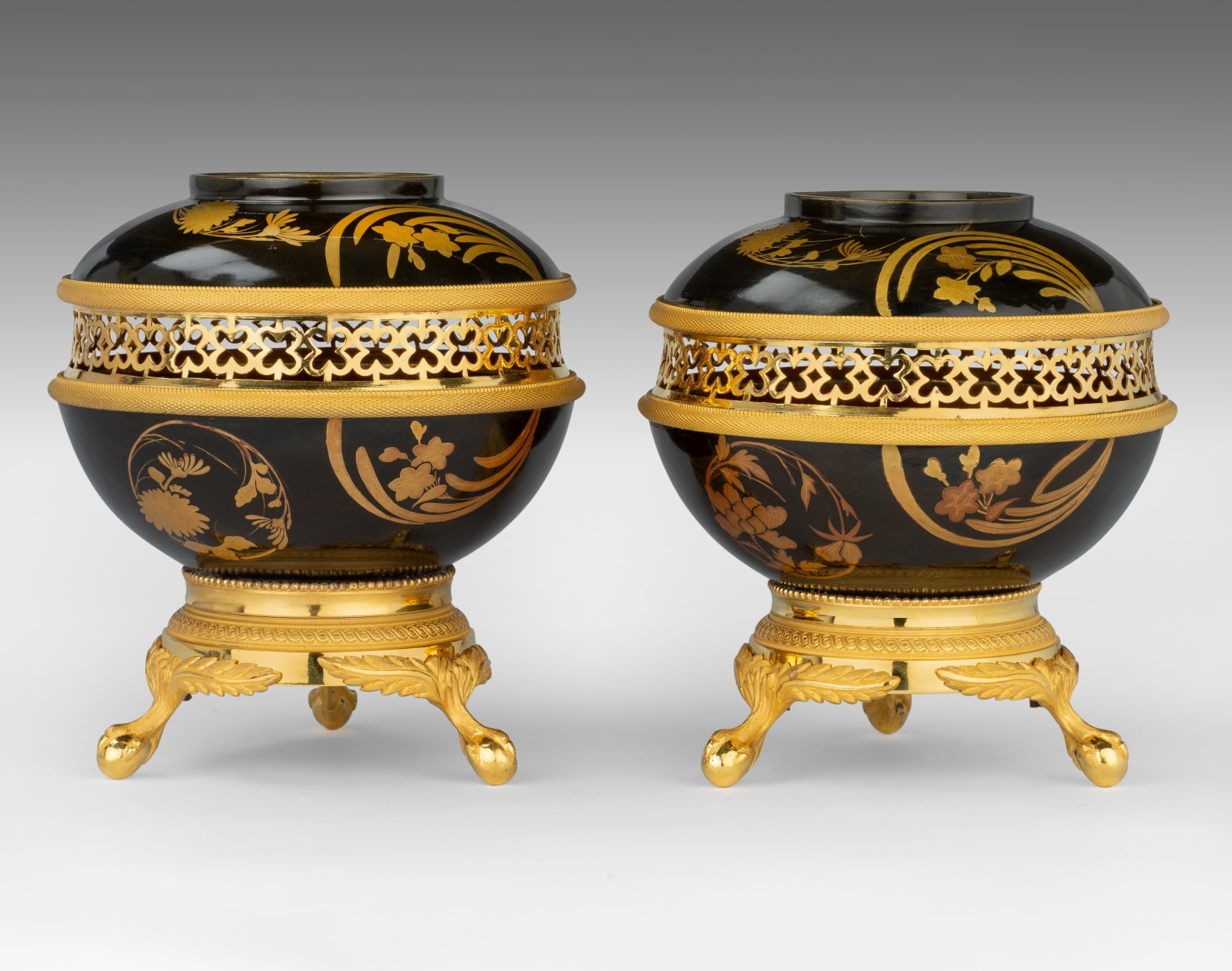SOLD TO THE METROPOLITAN MUSEUM OF ART - Pair of Late 18th Century Edo Period Japanese Lacquer Ormolu Mounted Cups and Covers formed as Pot Pourri Vases in London, attributed to Benjamin Vulliamy
ENGLAND, CIRCA 1800
5 3/4 x 5 1/2 in
14.5 x 14 cm
14.5 x 14 cm
6973
Further images
Provenance
Collection of Armand Charles François Marie de La Rochefoucauld, 7th Duc de Doudeauville, 6th Duca di Bisaccia, 9th Duc d'Estrées (1902-1995). (Not known if the 7th Duc acquired or inherited them).
By descent to his daughter Lise de La Rochefoucauld (born 1958), who became Mrs. Jean Pierre Ribes
Sold on her behalf by B. Fabre et Fils (Antiquaire), Paris, to Jeremy Ltd of London in 1998
Acquired by private collector (USA) from Jeremy Ltd in 1998
Ormolu mounted Japanese lacquered ‘pot pourri’ vases. The Japanese black lacquered bowls dating from the Edo period, late 18th century, decorated round the sides in gold with black details, with...
Ormolu mounted Japanese lacquered ‘pot pourri’ vases. The Japanese black lacquered bowls dating from the Edo period, late 18th century, decorated round the sides in gold with black details, with flowers and grasses formed as roundels. Each with a removable lid above a pierced frieze. The guilloche foliate moulded base with claw-and-ball feet.
Japanese lacquerware has always been highly prized in the West, but in the 18th century few examples reached Europe. Such rarity made lacquer all the more sought after and pieces were sometimes transformed to conform to western tastes and lifestyle.
Thomas Coulborn & Sons sold a similar pair of pot pourri vases in 2014.
Several similar examples, almost certainly commissioned by George IV, can be found in the Royal Collection (RCIN 3155, RCIN 3158, RCIN 2259, RCIN 3157). They were first housed at the Royal Pavilion, Brighton, before being transferred to Buckingham Palace.
Benjamin Vulliamy (1747-1811) was the eldest son of François Justin Vulliamy (1712–1797), a clockmaker of Swiss origin, who moved to London around 1730. He married the daughter of Benjamin Gray (c. 1676-1764), the then King’s Watchmaker. When Gray died, Vulliamy became a partner in the business at the age of 25 and his talent earned him a Royal Appointment in 1772, through which he received an annual endowment of £150 as King George III’s Clockmaker. His success in his designs for clocks led him to create other items such as ink stands and lighting and to design metalwork embellishments for fine objects. The Prince of Wales commissioned a range of furnishings for Carlton House and the extravagant Royal Pavilion at Brighton which included the addition of ormolu mounts for Chinese vases and pagodas.
Japanese lacquerware has always been highly prized in the West, but in the 18th century few examples reached Europe. Such rarity made lacquer all the more sought after and pieces were sometimes transformed to conform to western tastes and lifestyle.
Thomas Coulborn & Sons sold a similar pair of pot pourri vases in 2014.
Several similar examples, almost certainly commissioned by George IV, can be found in the Royal Collection (RCIN 3155, RCIN 3158, RCIN 2259, RCIN 3157). They were first housed at the Royal Pavilion, Brighton, before being transferred to Buckingham Palace.
Benjamin Vulliamy (1747-1811) was the eldest son of François Justin Vulliamy (1712–1797), a clockmaker of Swiss origin, who moved to London around 1730. He married the daughter of Benjamin Gray (c. 1676-1764), the then King’s Watchmaker. When Gray died, Vulliamy became a partner in the business at the age of 25 and his talent earned him a Royal Appointment in 1772, through which he received an annual endowment of £150 as King George III’s Clockmaker. His success in his designs for clocks led him to create other items such as ink stands and lighting and to design metalwork embellishments for fine objects. The Prince of Wales commissioned a range of furnishings for Carlton House and the extravagant Royal Pavilion at Brighton which included the addition of ormolu mounts for Chinese vases and pagodas.






